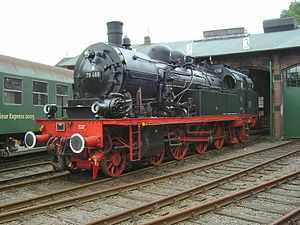Prussian T 18
| Prussian T 18 DRG Class 78.0–5 PKP OKo 1 | |
|---|---|
 | |
| Number(s): | DRG 78 001–330, 78 351–528 |
| Quantity: | 534 |
| Manufacturer: | Stettiner Maschinenbau AG Vulcan |
| Year(s) of manufacture: | 1912–1927 |
| Retired: | 1975 |
| Wheel arrangement: | 4-6-4T |
| Axle arrangement: | 2'C2' h2t |
| Type: | Pt 37.17 |
| Gauge: | 1,435 mm |
| Length over buffers: | 14,800 mm |
| Empty weight: | 83.2 t |
| Service weight: | 105.0 t |
| Adhesive weight: | 51.1 t |
| Axle load: | 17.0 t |
| Top speed: | 90 km/h (to 78 009) 100 km/h (from 78 010) |
| Indicated Power: | 838 kW |
| Driving wheel diameter: | 1,650 mm |
| Leading wheel diameter: | 1,000 mm |
| Trailing wheel diameter: | 1,000 mm |
| No. of cylinders: | 2 |
| Cylinder bore: | 560 mm |
| Piston stroke: | 630 mm |
| Boiler Overpressure: | 12 bar |
| No. of heating tubes: | 134 |
| No. of smoke tubes: | 24 |
| Heating tube length: | 4,700 mm |
| Grate area: | 2.44 m² |
| Radiative heating area: | 13.04 m² |
| Superheater area: | 49.20 m² |
| Evaporative heating area: | 138.34 m² |
| Brakes: | Compressed-air brake |
The Prussian Class T 18s were the last tank locomotives developed for the Prussian state railways. They were originally intended for services on the island of Rügen as replacements for Class T 12 and T 10 engines. They emerged when a class of locomotive was conceived in 1912 that was to handle express and passenger trains in border areas or in shuttle services on short routes. A tank engine design with symmetrical running gear was envisaged because, unlike a tender locomotive, it could run equally fast forwards and backwards and could be operated on return journeys without having to be turned on a turntable. Its power and top speed were to be the same as those of the P 8. Robert Garbe designed this 4-6-4 (2'C2') tank locomotive for 100 km/h with a 17 ton axle load and contracted the Vulkan Werke in Stettin to build it. It was given the designation T 18.
A total of 534 engines were built from 1912 to 1927, mainly by the Stettiner Maschinenbau AG Vulcan and, from 1923, also by Henschel, of which 458 alone went to the Prussian state railways and, subsequently, the Deutsche Reichsbahn. The Royal Württemberg State Railways received 20 T 18s in 1919, the Imperial Railways in Alsace-Lorraine 27 also in 1919, the Saar Railway (Saarbahn) 27 between 1922–25 and the Eutin-Lübeck Railway (Eutin-Lübecker Eisenbahn) one in each of the years 1936 and 1939.
The Reichsbahn took over 460 vehicles from Prussia and 20 from the Royal Württemberg State Railways, incorporating them into DRG Class 78 with operating numbers 78 001–282 and 78 351–528. Of these, number 78 093 came from Alsace-Lorraine and numbers 78 146–165 from Württemberg. Later the engines from the Saar Railway were numbered 78 283–328 and those of the Eutin-Lübeck Railway as 78 329 and 330.
The Deutsche Bundesbahn took over 424 engines and the Deutsche Reichsbahn in East Germany 53 examples. In 1968 only 35 engines remained with the DR in East Germany. In 1965 the DR fitted the majority of its engines with Giesl chimneys and Witte smoke deflectors. From 1968 the DB locomotives were reclassified into Class 078; in 1970 the DR regrouped its locomotives into Class 78.1.
The PKP took over some locomotives, classifying them as OKo 1.
The DB converted several Class 78s for push-pull running e.g. between Frankfurt and Wiesbaden. Because the engine driver in the driving coach could only work the brake, operation of the regulator and reversing gear was carried out by specially trained stokers as signalled by the engine driver. The last locomotives were retired by the DB in the mid-1970s at Rottweil locomotive depot (Bahnbetriebswerk or Bw). The farewell journey for this engine class and, at the same time for the Class 38s (Prussian P 8), took place on 31 December 1974. The event was organised by the Zollern Railway Friends. The trip was even reported on the German television channel, ARD.
Preserved Locomotives
Several T 18 are preserved in museums:
- 78 009 belongs to the Dresden Transport Museum fleet and is looked after by the IG Bahnbetriebswerk Dresden-Altstadt.
- 78 189, as OKo 1-3 belongs to the Warszawa Muzeum Kolejnictwa in Poland.
- 78 246 can be viewed at the German Steam Locomotive Museum (Deutschen Dampflokomotiv-Museum).
- 78 468 (see photograph) belongs to the city of Oberhausen and is operational. It is run by the Emscher Park Eisenbahn Gesellschaft.
- 78 510 belongs to the DB Museum's collection.
-

DR 78 009 in Potsdam (1993)
-

OKo 1-3 ex 78 189 Vulcan 3610-1920
-

DB 78 510 in the Nuremberg Transport Museum
See also
- Prussian state railways
- List of DRG locomotives and railbuses
- List of Prussian locomotives and railbuses
Sources
- Ebel / Knipping / Wenzel: Die Baureihe 78, Bewährt in sechs Jahrzehnten: Preußens T 18, EK-Verlag, Freiburg 1990, ISBN 978-3-88255-547-9
- Dietmar Falk: Die schnelle Preußin. Erinnerung an die T 18. In: LOK MAGAZIN. Nr. 265/Jahrgang 42/2003. GeraNova Zeitschriftenverlag GmbH München, ISSN 0458-1822, S. 50-60.
External links
-

Wikimedia Commons has media related to preußische T 18.
- There is a relevant English-language forum at Railways of Germany
| |||||||||||||||||||||||||||||||||||||